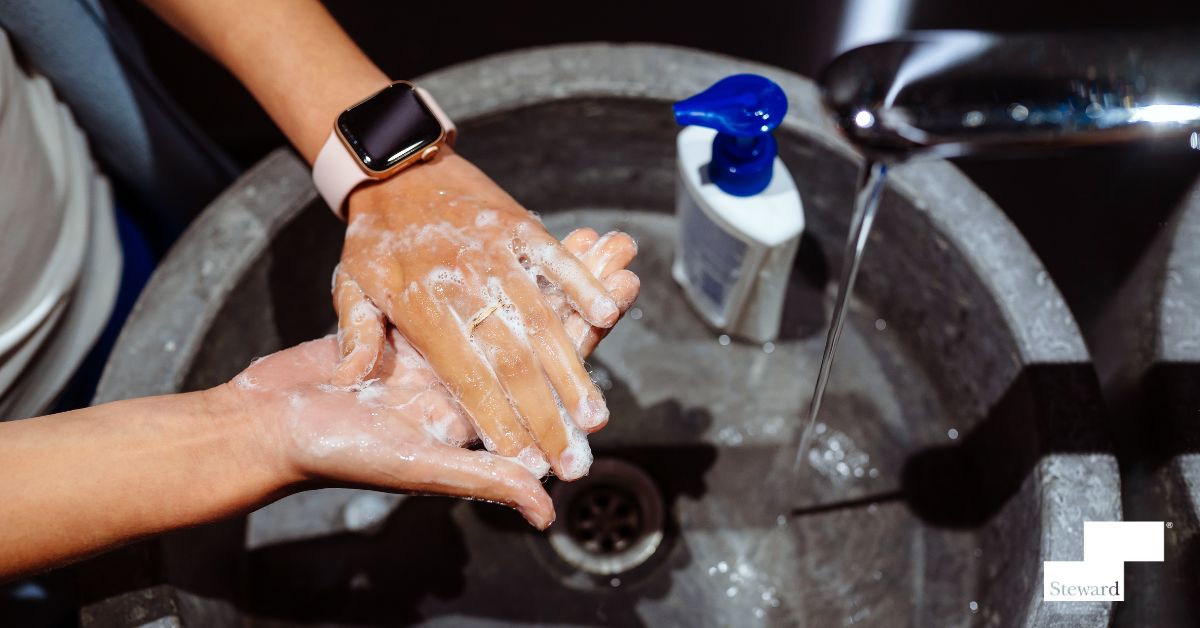As we approach Global Handwashing Day, I reflect on a series of pictures in my office of nurses in Great Britain during World War I. When I first became a Chief Nursing Officer (CNO), I wanted to find some pictures for my office that spoke to me about what nursing really means, and I found these photographs. The first is of a nurse making a bed; the second is of a nursing ward with the nurse looking cool, clean, and confident in her cap and whites; and the third is of a nurse sitting by the bedside of a badly burned soldier. Nearly eight years of being a CNO later, those pictures still strike me in the ways that nursing has changed. But even more so, those pictures remind me of the ways nursing has not changed. When providing care for our patients when they need us most, cleanliness and a compassionate hand to hold make a huge difference in patient outcomes.
Handwashing is the first step when it comes to cleanliness. Handwashing isn’t just a big deal in health care; handwashing makes a huge difference for everyone when it comes to disease prevention. As Saima Abbas, MD, puts it simply, “[handwashing] saves lives.” Handwashing as a preventative practice against infection is largely credited to Florence Nightingale, the mother of modern nursing, beginning back in the 1860s during the Crimean War. She was able to prove that handwashing decreased infections and deaths among the wounded. She based her theories largely on the 1840s work of Dr. Ignaz Semmelweis. He noticed that in his hospital, the maternal mortality rate was nearly three times higher when doctors delivered babies than when delivered by a midwife. He discovered the difference was because the doctors went from other patients and even autopsies to their maternal patients, whereas the midwives only went between maternal patients. When he started having doctors wash their hands before going to the maternal wards, the mortality rate decreased dramatically. Despite his and Florence Nightingale’s work, routine handwashing for surgeons only became a practice starting in the late 1870s. Even with all the knowledge about the difference handwashing made in preventing disease in health care, routine handwashing outside of the health care setting took over 100 years to become established. Routine handwashing outside of health care did not become a recommendation until the 1980s!
Did you know the top two killers of children around the world are diarrheal disease and pneumonia? According to the Centers for Disease Control and Prevention (CDC), 1.8 million children under the age of five die each year from these two conditions. One out of three diarrhea cases and one out of five pneumonia cases in children under the age of five are preventable by properly washing hands with soap and water after using the toilet. Yet, the world-wide average for handwashing with soap and water after using the toilet is only an alarming 19%.
You’ve likely found yourself saying before that “children are little magnets for germs.” As children explore, a natural part of their development, they come into contact with many objects that we know to avoid as adults. As they touch countless surfaces throughout the day, they pick up bacteria and viruses along the way. As they touch their faces, especially the eyes, nose, and mouth, these germs find a way into their bodies (or they pass these germs on to their family members), making them susceptible to illnesses. Regular handwashing disrupts this process, significantly reducing the risk of infection. Handwashing and access to soap in schools improve attendance, and good handwashing habits early in life have even been linked to improved child development in some populations. And frequent handwashing prevents many types of eye infections. As we are faced with a rise in antibiotic resistance, handwashing helps reduce antibiotic use and, subsequently, helps reduce antibiotic resistance.
There are seven steps to properly washing your hands. 1) Wet your hands with clean, preferably running, water. 2) Apply enough soap to cover all surfaces of your hands and wrists. 3) Lather and rub your hands together, making sure to scrub all surfaces, including your fingernails and writs. 4) Scrub for at least 20 seconds. Many smart watches can now detect and time your handwashing. Singing the “Happy Birthday” song in your head twice also takes about 20 seconds. 5) Rinse your hands and wrists under clean, preferably running, water. 6) Dry your hands and wrists with a clean towel or let them air-dry. 7) Use a towel to turn off the faucet and open doors. Hand sanitizer is a great option if you can’t handwash because of time or limitations in the available facilities, but it should not be considered a better option. Hand sanitizer will not help with hands that are obviously soiled. In those cases, it is better to use soap and water.
Wash your hands frequently, particularly after using the toilet, after coughing, sneezing, or blowing your nose, when your hands look dirty, after working or playing outdoors, before eating, and after touching animals or their bedding areas. If you are in a health care setting, it is perfectly okay to ask your caregiver if they have washed their hands. I highly encourage you to do so because that hand you may need to hold also needs to be a clean one.
Handwashing might seem like such a small act, but its impact is powerful. It’s a foundational habit that protects us from diseases, saves lives, and strengthens our community’s overall health. I encourage you to make this one small change a non-negotiable part of your daily routine. Remember, every time you wash your hands, you’re not just protecting yourself—you’re safeguarding the entire community, one wash at a time. Together, let us spread the message: clean hands save lives.

Carol A. Cates, MSN, MBA, RN
Chief Nursing Officer
Odessa Regional Medical Center
To find a doctor or schedule an appointment, visit Steward DoctorFinder™.




